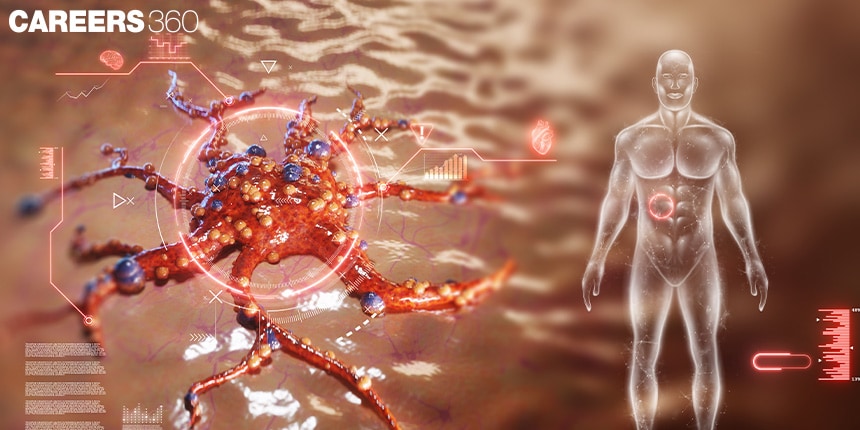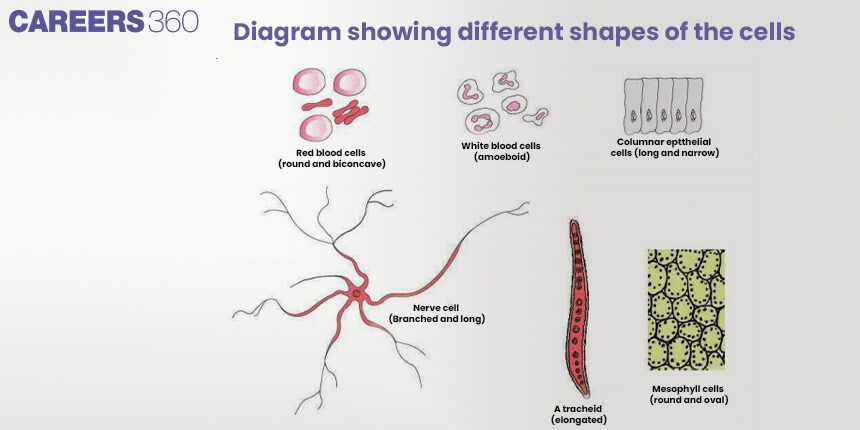Types of Cells in Human Body
Cells are the basic structure of all living things, including the human body. Each cell operates practically as a separate entity that can perform the fundamental processes of life. In humans, cells work together to maintain health and proper functioning; otherwise, human existence would not be there.
Don't Miss: Most scoring concepts for NEET | NEET papers with solutions
NEET 2025: Syllabus | PYQs | Crack NEET in 2 months - Study Plan
NEET Important PYQ & Solutions: Physics | Chemistry | Biology | NEET PYQ's (2015-24)
- Classification Of Human Cells
- Detailed Analysis Of Major Cell Types
- Conclusion

The human body is comprised of a wide variety of cell types, performing many functions. Each of these cell types has a very special role in helping to form the functioning whole that is the human body. That allows for a very formalised performance, yet specialised, in the performance of very specific tasks necessary for life.
Classification Of Human Cells
The cells are classified as:
Epithelial Cells
Closely packed cells with a minimal amount of extracellular matrix.
Tissues are organized in continuous sheets, covering surfaces or lining cavities.
Barrier against mechanical injury, pathogens, and fluid loss.
Permits uptake of nutrients and other substances
Manufactures and secretes enzymes, hormones and mucus.
Examples
Skin cells
The lining of the digestive tract
Connective Tissue Cells
Provides support
Helps in binding
Maintains insulation
Examples
Bone cells (osteocytes)
Blood cells (red and white blood cells)
Cartilage cells (chondrocytes)
Muscle Cells
Helps in movement
Contraction
Examples
Skeletal Muscle Cells
Cardiac Muscle Cells
Smooth Muscle Cells
Nerve Cells (Neurons)
Transmission of nerve impulses
Types Of Neurons
Sensory Neurons
Motor Neurons
Interneurons
Stem Cells
Differentiation into various cell types
Tissue repair and regeneration
Types Of Stem Cells
Embryonic Stem Cells
Adult Stem Cells
Diagram showing different types of cells present in the human body.

Detailed Analysis Of Major Cell Types
The major cell types are described below
Red Blood Cells (Erythrocytes)
The erythrocytes, or red blood cells, are biconcave, disc-shaped cells that do not have a nucleus.
This shape gives a larger surface area to the cell for an increased rate of oxygen transport.
These cells are full of haemoglobin, which can bind and carry oxygen from the lungs to the tissues.
In return, they bring back carbon dioxide to the lungs for exhalation.
Erythrocytes live for approximately 120 days and then get phagocytosed in the spleen and liver.
However, macrophages constantly replace them by erythropoiesis in the bone marrow.
White Blood Cells (Leukocytes)
White blood cells or leukocytes compose the defence system of the body with different types of specialised defence strategies.
Neutrophils, being the most numerous, take up the role of first attack against invading microorganisms; they engulf the pathogens and destroy them.
The lymphocytes, which consist of B cells and T cells, are involved in adaptive immunity, where the B cells synthesise and present antigens and T cells attack infected cells.
Thus, the monocytes give rise to the macrophages and the dendritic cells, which are phagocytic and antigen-presenting cells.
Eosinophils kill multi-cellular parasites and also have a role in allergic responses.
Basophils are responsible for releasing histamine and other chemical mediators of inflammation in the inflammatory response.
Platelets (Thrombocytes)
They are small, disc-like cell fragments, the products of megakaryocyte cellular meningitis in the bone marrow.
As they lack a nucleus, they are packed full of granules containing enzymes and factors that help blood to clot.
Injured vessels expose collagen fibrils to the platelets which then release chemical factors that initiate a series of clotting reactions.
This represents a method by which excessive loss of blood is prevented and wounds can heal.
Muscle Cells
Myocytes are highly specialised to contract, with mainly three different types.
Skeletal muscle cells are long, multinucleated fibres that have a striped or striated appearance due to the arrangement of contractile units called sarcomeres.
They are in charge of voluntary movements, which include walking and running, and they are attached to the bones using tendons.
The cardiac muscle cells are located in the wall of the heart; they are striated, have a single nucleus, and their fibres are branched.
Nonstriated, fusiform smooth muscle cells are embedded in the walls of hollow organs, the intestines and blood vessels bringing about involuntary movements like peristalsis and vasoconstriction.
Skin Cells
It is the largest organ of the body, made up of different cell types.
Keratinocytes are cells that make up the epidermis, the tough outermost layer of skin cells which prevent water loss from the body.
The epidermis also safeguards the body from infections.
Melanocytes are present in skin, hair, and eyes.
They produce melanin that is responsible for skin colour and protection from UV rays.
Langerhans cells are present in the upper layer of the epidermis and serve as antigen-presenting cells.
They activate the immune system once an infection occurs in the body.
The tactile epithelial cells, or Merkel cells, situated just below the epidermis, are very important for touch and pressure sensation on the skin.
Bone Cells
Cells that give bones their tissue form are known as bone cells.
There are three different categories of cells, that is, osteoclasts, osteoblasts, and osteocytes, which are categorised according to function.
Osteoclasts resorb and break down bone tissue and produce new bone tissue.
Osteocytes, in fully developed bones, respond to mechanical stress, either signal for bone resorption or formation, and control mineral homeostasis both at the local and systemic levels.
Fat Cells
Fat cells, otherwise adipocytes, also have a function as far as weight, size, and number are concerned.
There are two types of these cells: white adipocyte cells and brown adipocyte cells.
White adipocytes store energy in the form of triglycerides, while brown adipocytes burn it to release heat through thermogenesis.
Their production changes with age, shifting to fewer white fat cells and a larger number of brown fat cells, thus affecting the metabolic process of energy and the regulation of body weight.
Conclusion
There are numerous kinds of cells present in the human body; all have a special function that helps an organism to be healthy and thus alive. These are cells protecting epithelial cells, contracting muscle cells, and immunity-improving cells or white blood cells. As suggested by their name, each cell type has unique functions to ensure the smooth functioning of organs and systems. Specialisation allows cells to perform difficult tasks of movement or locomotion, digestion, processing food, immunity, or simply sensing the world.
Looking Ahead Continued research in cell biology offers the promise of many medical breakthroughs, a better understanding of complex disease states, regenerative treatment options, and an overwhelming area of future study. Discoveries from such cell biology research will also enhance the natural histories of many diseases, and new therapies can be developed while present ones improve.
Frequently Asked Questions (FAQs)
The human body contains different types of cells, including epithelial cells, muscle cells, nerve cells (neurons), and blood cells (red and white blood cells).
Epithelial cells protect underlying tissues, absorb nutrients, and secrete substances like hormones and enzymes.
Muscle cells contract to move, while nerve cells transmit electrical signals for communication between different parts of the body.
Stem cells are undifferentiated cells capable of developing into various specialised cell types. They are crucial for tissue repair, regeneration, and medical research.
Red blood cells transport oxygen from the lungs to tissues and carry carbon dioxide back to the lungs. White blood cells defend against infections and foreign substances through immune responses.
Also Read
27 Dec'24 05:51 PM
23 Nov'24 05:46 PM
08 Nov'24 05:04 PM
08 Nov'24 10:59 AM
08 Nov'24 09:54 AM
08 Nov'24 09:26 AM
08 Nov'24 09:01 AM
07 Nov'24 10:17 PM
07 Nov'24 09:50 PM
07 Nov'24 04:38 PM